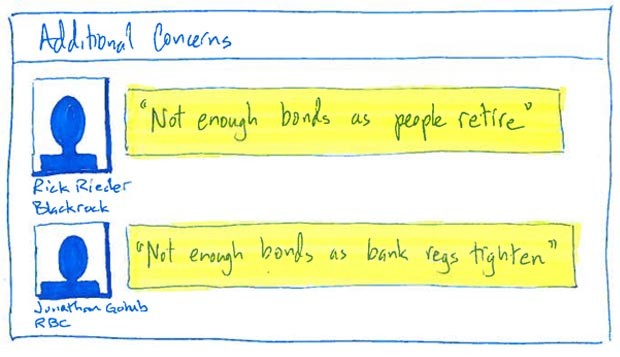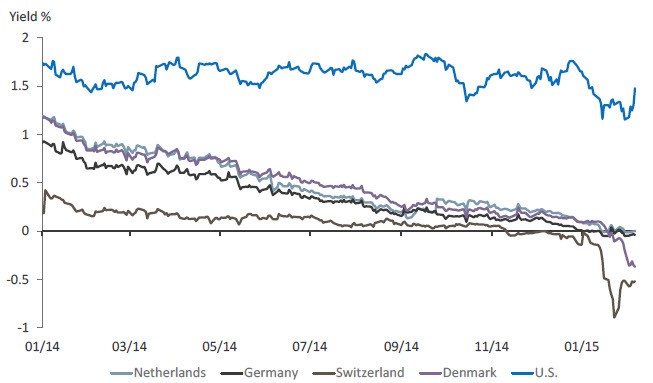How to Fight Shrinking Bond Yields Bloomberg Business
Post on: 30 Март, 2015 No Comment

Scott Ingram Photography
It’s only a month into 2015, and the first act for bonds has been another unpredictable, off-script adventure. Defying expectations that this would be the Year of Rising Interest Rates, the yield on the 10-year U.S. Treasury note has limboed down from 2.2 percent to 1.7 percent, the lowest it’s been since May 2013.
That 1.7 percent is a lot better than the 0.4 percent yield on the 10-year German bund, sure. But gloating isn’t an investment strategy, and 1.7 percent is nothing to cheer about. Nor is the 2.3 percent yield for the iShares Core U.S. Aggregate Bond Exchange-Traded Fund (AGG ).
Income investors have a smarter option. And no, it doesn’t involve junk. An A-rated 10-year municipal bond has a taxable equivalent yield of about 3.5 percent for investors in the 28 percent federal tax bracket. (That’s single filers with taxable income of at least $189,000 and married couples filing a joint tax return with income topping $230,451.)
Taxpayers in higher federal brackets are looking at taxable equivalent yields of 3.7 percent to 4.2 percent. It gets better if you can also shield that income from state and local income tax. And if you’re in the crosshairs of the 3.8 percent federal net investment income tax that’s part of the Affordable Care Act, muni bond income is exempt from that health-care surtax. “I tell all my high-net-worth clients they should only consider municipal bonds,” says Marilyn Cohen, chief executive officer of Envision Capital Management, which manages bond portfolios for individuals.
While a stronger economy should eventually send bond yields higher and prices lower, there’s a silver lining if you’re a muni investor. “Growth and falling unemployment brings in more revenue for states, and rising home prices is good news for local issuers who are more dependent on property tax revenue,” says J.R. Rieger, global head of fixed income at S&P Dow Jones Indices. And supply remains tight. The $332 billion in net new issuance last year was down from 2013 and well below the record $427 billion in new bonds sold in 2007.
Meanwhile, demand is picking up. After retail investors high-tailed it out of muni bond funds and ETFs in 2013 (more on that in a minute), muni funds had inflows of $32 billion last year, according to Morningstar. Close to $11 billion flowed in during the fourth quarter. James Kochan, chief fixed income strategist at Wells Fargo Advantage Funds, notes that in mid-2014 property and casualty insurers bought muni bonds for the first time in three years, having worked their way past big payouts for natural disasters.
Buying Strategy: Keep Cool
Even so, more than 75 percent of muni bonds are owned by individuals, according to a 2012 U.S. Securities and Exchange Commission report. And let’s just say that your fellow investor has a tendency to get spooked by scary headlines that may not reflect the muni market’s broad fundamentals. So a cool head will give you an edge.
Remember the late 2010 scare when Wall Street analyst Meredith Whitney warned of big municipal defaults? Investors pulled more than $25 billion from munis in two months. When Armageddon failed to materialize, fund flows reversed course in 2011, and the average intermediate-term municipal bond fund gained 11 percent.

Then, in 2013, investors were scared by Detroit’s bankruptcy and Puerto Rico’s fiscal woes. They yanked more than $58 billion from muni funds and ETFs, according to Morningstar—despite the fact that neither event was a surprise to pros in these markets and was already reflected in pricing. It was clearly not the harbinger of a systemic problem for the $3.6 trillion muni market. As that became apparent to retail investors, funds and ETFs had net inflows of almost $32 billion in 2014, and the average intermediate-term fund gained 7 percent.
You get the idea: Be greedy when other muni bond investors get fearful.
Because of last year’s strong rally, Wells Fargo’s Kochan recommends waiting for the next market hiccup before investing. That could be the much anticipated interest rate rise, or a headline news event. One potential trigger for the latter could be that any increased congressional chatter of tax reform could cause muni jitters, because tax-exempt income is typically tossed into the pool of areas ripe for reform. “It always comes up, yet it is never touched,” Kochan says.
The sweet spot in munis now? An intermediate duration in the 7- to 12-year range, says Envision Capital Management’s Cohen. You get a solid yield without the price volatility that longer-term issues face when rates do rise. A cost-effective way to invest is through diversified funds and ETFs. The Vanguard Intermediate-Term Tax-Exempt (VWITX ) mutual fund has a 3 percent trailing 12-month yield. That equals almost 4.2 percent for investors in the 28 percent federal tax bracket.
Vanguard plans to roll out its first muni bond ETF this year, going head to head with the iShares National AMT-Free Muni Bond ETF (MUB ). The Vanguard ETF will charge a 0.2 percent expense ratio, undercutting the 0.25 percent for the iShares ETF. The trailing 12-month yield for the iShares portfolio is 2.7 percent, which equals 3.75 percent for investors in the 28 percent federal tax bracket. It will likely be a long time before the 10-year Treasury sports a yield like that.
Carla Fried is a freelance writer based in California.














